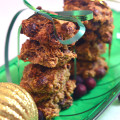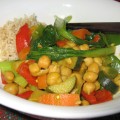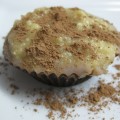The holidays are here, and it’s time for Peter to dust off his Swedish cookbook and make pepparkakor, a traditional Swedish ginger cookie. Peter has fond memories of his mom making home-made pepparkakor as a child, and now he’s instilling those memories in our boys. Every year he collects all of the ingredients together, with a quick run to IKEA for any missing items, and then he creates a massive mound of pepparkakor dough that will chill overnight before he starts rolling out dozens and dozens of cookies. The secret of pepparkakor is their thin, crispness. While Americans like a thick, cakey gingerbread cookie, the Swedes like thin, crisp little wafers with no decorations or icing. Nowadays, you can buy prepared pepparkakor dough in Sweden, but Peter still does it the old-fashioned way.
In Sweden, hosts and moms set out dishes of pepparkakor during the holidays for a little treat, and they’re especially good served with glögg, a traditional hot spiced wine. All during the month of December, the Swedes celebrate the holidays with glögg gatherings, during which they serve tiny, steaming cups of spicy red wine with raisins and almonds. And it’s essential to serve this festive drink with a tray of pepparkakor.
Here’s my husband’s recipe for pepparkakor. I hope you enjoy the holidays! It is translated directly from Swedish.
 Peter’s Pepparkakor (Swedish Gingerbread Cookies)
Peter’s Pepparkakor (Swedish Gingerbread Cookies)
Ingredients:
11 oz (300 grams) margarine (dairy-free), room temperature
2 cups sugar
1/3 cup & 1 tablespoon light corn syrup (Swedish brand is available at IKEA)
1 tablespoon ginger
2 tablespoons cinnamon
1 tablespoon cloves
2 teaspoons fine cardamom
1 tablespoon baking soda
¾ cup + 2 tablespoons water
6 cups flour
Directions:
1. Mix margarine with the sugar and the syrup until smooth. It is recommended to use an electric whisk.
2. Mix in the spices and the baking soda, then the water and then some of the flour, so that the dough is not too sticky.
3. Remove the dough from the bowl and mix in the rest of the flour on a baking table or counter top.
4. When the dough is done, wrap it in foil and let it rest for 24 hours in the refrigerator.
5. Remove a little bit of the dough at a time, roll it thin (use more flour as needed so that it doesn’t stick to the counter or the roller, but not too much which will make the cookies hard), then use whatever shapes you want to cut the cookies. Note: the dough is rolled out very, very thin!
6. Use a little bit of margarine on a paper towel to lightly grease the baking sheets before you put the cookies on them. It is typically enough to just do that once.
7. Put the sheets in the middle of the oven for about 5 minutes or until the cookies have a light brown color. Oven temperature should be around 390 F. Makes 6 dozen cookies.
Images by Sharon Palmer
About the author: Sharon Palmer, RDN, The Plant-Powered Dietitian™, is an award-winning food and nutrition expert, journalist, and editor. She is author of The Plant-Powered Diet: The Lifelong Eating Plan for Achieving Health, Beginning Today (The Experiment, 2012) and Plant-Powered for Life: Eat Your Way to Lasting Health with 52 Simple Steps & 125 Delicious Recipes (The Experiment, 2014). Sharon also is editor of Environmental Nutrition, nutrition editor of Today’s Dietitian, blogger for The Plant-Powered Blog, and publisher of her monthly The Plant-Powered Newsletter. Living in the chaparral hills overlooking Los Angeles with her husband and two sons, Sharon enjoys visiting her local farmers market, gardening, and cooking for friends and family.







No Comments